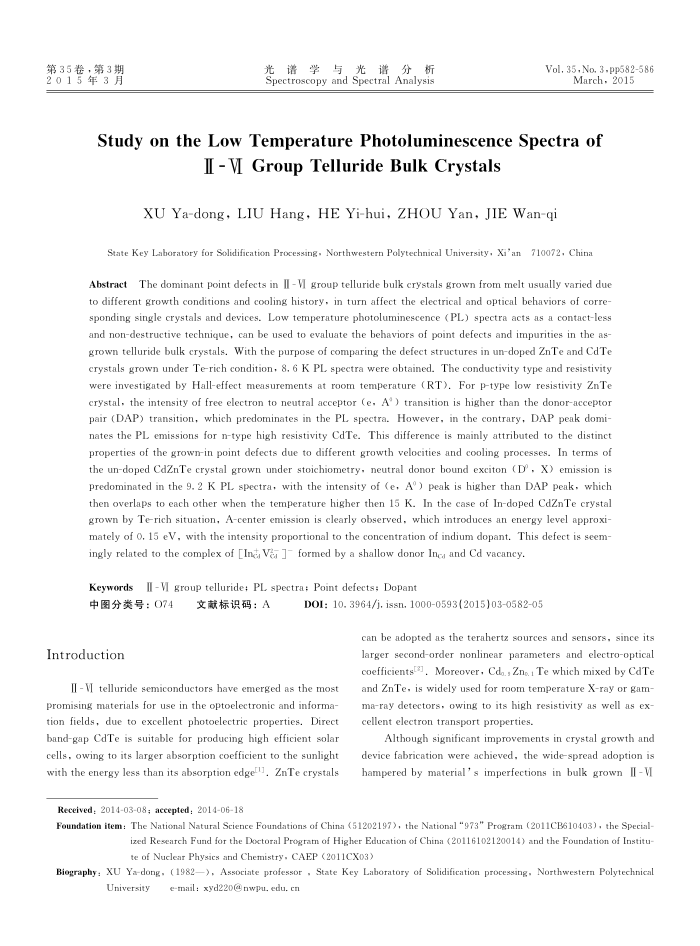您当前的位置:首页>论文资料>Ⅱ-Ⅵ族碲化物体单晶低温光致发光谱研究
内容简介
 第35卷,第3期 2015年3月
第35卷,第3期 2015年3月光谱学与光谱分
析
Spectroscopy and Spectral Analysis
Vol, 35,No., 3 - pp582-586
March, 2015
StudyontheLowTemperaturePhotoluminescenceSpectraof
I -V Group Telluride Bulk Crystals
XUYa-dong,LIUHangHEYi-hui,ZHOUYan,JIEWan-qi
State Key Laboratory for Solidification Processing, Northwestern Polytechnical University, Xi'an 710072, China
The dominant point defects in Il - VI group telluride bulk crystals grown from melt usually varied due
Abstract
to different growth conditions and cooling history, in turn affect the electrical and optical behaviors of corre-sponding single crystals and devices. Low temperature photoluminescence (PL) spectra acts as a contact-less and non-destructive technique, can be used to evaluate the behaviors of point defects and impurities in the as grown telluride bulk crystals, With the purpose of comparing the defect structures in un-doped ZnTe and CdTe crystals grown under Te-rich condition, 8, 6 K PL spectra were obtained. The conductivity type and resistivity were investigated by Hall-effect measurements at room temperature (RT). For p-type low resistivity ZnTe crystal, the intensity of free electron to neutral acceptor (e, A*) transition is higher than the donor-acceptor pair (DAP) transition, which predominates in the PL spectra.
However, in the contrary, DAP peak domi-
nates the PL emissions for n-type high resistivity CdTe. This difference is mainly attributed to the distinct properties of the grown-in point defects due to different growth velocities and cooling processes. In terms of the un-doped CdZnTe crystal grown under stoichiometry, neutral donor bound exciton (D’ , X) emission is predominated in the 9. 2 K PL spectra, with the intensity of (e, A°) peak is higher than DAP peak, which then overlaps to each other when the temperature higher then 15 K. In the case of In-doped CdZnTe crystal grown by Te-rich situation, A-center emission is clearly observed, which introduces an energy level approxi-mately of o, 15 eV, with the intensity proportional to the concentration of indium dopant. This defect is seem-ingly related to the complex of [Int, Ve J- formed by a shallow donor Iner and Cd vacancy.
II-VI group telluride; PL, spectra; Point defects; Dopant
Keywords
中图分类号:074
Introduction
文献标识码:A
D0I: 10. 3964/j. issn, 1000-0593 (2015)03-0582-05
can be adopted as the terahertz sources and sensors, since its larger second-order nonlinear parameters and electro-optical coefficients[3], Moreover, Cd,., Zns, Te which mixed by CdTe
II - VI telluride semiconductors have emerged as the most promising materials for use in the optoelectronic and informa-tion fields, due to excellent photoelectric properties. Direct band-gap CdTe is suitable for producing high efficient solar cells, owing to its larger absorption coefficient to the sunlight with the energy less than its absorption edgell. ZnTe crystals
Received: 2014-03-08; aeepted: 2014-06-18
and ZnTe, is widely used for room temperature X-ray or gam-ma-ray detectors, owing to its high resistivity as well as ex cellent electron transport properties.
Although significant improvements in crystal growth and device fabrication were achieved, the wide-spread adoption is hampered by material' s imperfections in bulk grown II-VI
Foundation item: The National Natural Science Foundations of China (51202197), the National "973" Program (2011CB610403) , the Special-
ized Research Fund for the Doctoral Program of Higher Education of China (20116102120014) and the Foundation of Institu-te of Nuclear Physics and Chemistry CAEP (2011CX03)
Biography: XU Ya-dong, (1982), Associate professor , State Key Laboratory of Solidification processing, Northwestern Polytechnical
University
e-mail:xyd220@nwpu.edu. cn